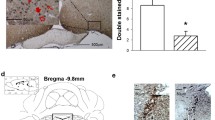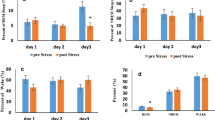Abstract
Rationale
The expression of sleep is influenced by situations that take place during the preceding waking period, giving rise to different patterns of sleep architecture. Immobilization stress (IMB) induces an increase of both rapid eye movement (REM) and slow wave sleep (SWS). It has been suggested that these changes are mediated in part by noradrenaline and by the corticotrophin releasing factor.
Objective
To determine the participation of mu receptors in the stress-induced increase of REM sleep using naltrexone (NTX).
Methods
Twelve adult male rats were implanted for sleep recordings. Subjects were recorded under control conditions as well as after: a) IMB stress (1 h); b) injection of NTX (1.5 mg/kg); c) NTX plus IMB. To assess corticosterone levels, additional groups (n=5) were decapitated at 0, 1, 3 and 6 h after vehicle injection and after immobilization. Four groups were decapitated at 0, 1, 3, and 6 h after NTX plus IMB. Corticosterone plasma levels were determined by HPLC.
Results
IMB induces an increase in REM and SWS, and a decrease in wakefulness. Administration of NTX before IMB suppresses the effects of stress on sleep. NTX administration is innocuous in non-stressed animals. However, NTX administration does not prevent the rise of corticosterone normally observed after IMB stress.
Conclusion
These data suggest that NTX prevents the effects of IMB stress on sleep by acting outside of the hypothalamic-pituitary-adrenal axis that partially mediates the stress response.



Similar content being viewed by others
References
Ambrosini MV, Sadile AG, Girone A, Carnevale UA, Mattiaccio M, Giuditta A (1988) The sequential hypothesis: I evidence that the structure of sleep depends on the nature of the previous waking experience. Physiol Behav 43:325–337
Arankowsky-Sandoval G, Gold PE (1995) Morphine-induced deficits in sleep patterns: attenuation by glucose. Neurobiol Learn Mem 64:133–138
Baubet V, Fèvre-Montagne M, Gay N, Debilly G, Bobillier P, Cespuglio R (1994) Effects of an acute immobilization stress upon propiomelanocortin (POMC) mRNA levels in the mediobasal hypothalamus: a quantitative in situ hybridization study. Mol Brain Res 26:163–168
Cespuglio R, Houdouin F, Oulerich M, El Mansari M, Jouvet M (1992) Axonal and somato-dendritic modalities of serotonin release: their involvement in sleep preparation, triggering and maintenance. J Sleep Res 1:150–156
Dalayeun JF, Nores JM, Bergal S (1993) Physiology of beta-endorphins. A close-up view and a review of the literature. Biomed Pharmacother 47:311–320
Davis GC, Duncan WC, Gillin JC, Bunney WE Jr (1977) Failure of naloxone to affect human sleep. Commun Psychopharmacol 1:489–92
De Andres I, Caballero A (1989) Chronic morphine administration in cats: effects on sleep and EEG. Pharmacol Biochem Behav 32:519–526
Drucker-Colín R (1995) The function of sleep is to regulate brain excitability in order to satisfy the requirements imposed by waking. Behav Brain Res 69:1117–1124
Duarte-Palma B, Suchecki D, Tufik, S (2000) Differential effects of acute cold and footshock on sleep of rats. Brain Res 861:97–104
Garzon M, Tejero S, Beneitez AM, De Andres I (1995) Opiate microinjections in the locus coeruleus area of the cat enhance slow wave sleep. Neuropeptides 28:229–239
Gonzalez MM, Valantx JL (1997) Participation of CRF in paradoxical sleep increase induced by stress or sleep deprivation. Sleep Res 26:194
Gonzalez MM, Debilly G, Valantx JL, Jouvet M (1995) Sleep increase after immobilization stress: role of the noradrenergic locus coeruleus system in the rat. Neuroscience Lett 202:5–8
Grzanna R, Molliver ME (1980) The locus coeruleus in the rat: an immunohistochemical delineation. Neuroscience 5:21–40
Kay DC, Eisenstein RB, Jasinski DR (1969) Morphine effects on human REM state, waking state and NREM sleep. Psychopharmacologia 14:404–416
King C, Masserano JM, Codd E, Byrne WL (1981) Effects of beta-endorphin and morphine on the sleep-wakefulness behavior of cats. Sleep 4:259–262
Lantos TA, Gorcs TJ, Palkovits M (1985) Immunohistochemical mapping of neuropeptides in the premamillary region of the hypothalamus in rats. Brain Res Rev 20:209–249
Lesscher HM, Bailey A, Burbach JP, Van Ree JM, Kitchen I, Gerrits M (2003) Receptor-selective changes in mu-, delta-, and kappa-opioid receptors after chronic naltrexone treatment in mice. Eur J Neurosci 17:1006–1012
Mansour A, Watson SJ (1993) Anatomical distribution of opioids receptors in mammalians: an overview. In: Hertz A (ed) Opioids I, Handbook of experimental pharmacology, vol 104. Springer, New York, pp 79–106
Marinesco S, Bonnet C, Cespuglio R (1999) Influence of stress duration on the sleep rebound induced by immobilization in the rat: a possible role for corticosterone. Neuroscience 92:921–933
Moyse E, Marcel D, Leonard K, Beaudet A (1997) Electron microscopic distribution of mu opioid receptors on noradrenergic neurons of the locus coeruleus. Eur J Neurosci 9:128–139
Mulder AH, Schoffelmeer ANM (1993) Multiple opiod receptors and presynaptic modulation of neurotransmitter release in the brain. In: Hertz A (ed) Opioids I, Handbook of experimental pharmacology, vol 104. Springer, New York, pp 125–144
Norman R, Smith C (1992) Restraint inhibits luteinizing hormone and testosterone secretion in intact male Rhesus macaques: effects of concurrent naloxone administration. Neuroendocrinology 55:405–415
North RA, Williams JT (1985) On the potassium conductance increased by opioids in rat locus coeruleus neurones. J Physiol 364:265–280
Rampin C, Cespuglio R, Chastrette N, Jouvet M (1991) Immobilization stress induces a paradoxical sleep rebound in rat. Neurosci Lett 126:113–118
Reinoso Barbero F, De Andres I (1995) Effects of opioid microinjections in the nucleus of the solitary tract on the sleep-wakefulness cycle states in cats. Anesthesiology 82:144–152
Robert C, Stinus L, Limoge A, (1999) Sleep impairments in rats implanted with morphine pellets. Neuropsychobiology 40:214–217
Sevcik J, Finta EP, Illes P (1993) Galanin receptors inhibit the spontaneous firing of locus coeruleus neurones and interact with mu-opioid receptors. Eur J Pharmacol 230:223–230
Takeuchi E (1970) Polygraphical study on the wakefulness-sleep cycle of the rat. Jpn J Psychol 41:248–256
Toates FM (1995) Stress-conceptual and biological aspects. Wiley, West Sussex, UK
Tortella FC, Moreton JC, Khazan N (1978) Electroencephalographic and behavioral effects of d-Ala2-methionine-enkephalinamide and morphine in the rat. J Pharmacol Exp Ther 206:636–646
Vaccarino AL, Olson GA, Olson RD, Kastin AJ (1999) Endogenous opiates: 1998. Peptides 20:1527–1574
Valentino RJ, Van Bockstaele E (2001) Opposing regulation of the locus coeruleus by corticotropin-releasing factor and opioids. Potential for reciprocal interactions between stress and opioid sensitivity. Psychopharmacology 158:331–342
Valentino RJ, Foote SL, Page ME (1993) The locus coeruleus as a site for integrating corticotropin-releasing factor and noradrenergic mediation of stress responses. Ann NY Acad Sci 697:173–188
Van Bockstaele EJ, Commons KG (2001) Internalization of mu receptors produced by etorphine in the rat locus coeruleus. Neuroscience 108:467–477
Vázquez-Palacios G, Velazquez-Moctezuma J (2000) Effect of electric foot shocks, immobilization and corticosterone administration on sleep-wake pattern in the rat. Physiol Behav 71:23–28
Wand GS, Mangold D, El Deiry S, McCaul ME, Hoover D (1998) Family history of alcoholism and hypothalamic opioidergic activity. Arch Gen Psychiatry 55:1114–1119
Woodward JH, Emery PW (1987) Determination of plasma corticosterone using high-performance liquid chromatography. J Chromatogr 419:280–284
Yamauchi N, Shibasaki T, Wakabayashi I, Demura H (1997) Brain beta-endorphin and other opioids are involved in restraint stress-induced stimulation of the hypothalamic-pituitary-adrenal axis, the sympathetic nervous system, and the adrenal medulla in the rat. Brain Res 777:140–146
Yang YR, Lee EH, Chiu TH (1998) Electrophysiological and behavioral effects of Tyr-d-Arg-Phe-Sar on locus coeruleus neurons of the rat. Eur J Pharmacol 351:23–30
Acknowledgements
The authors want to express their gratitude to Edith Monroy, and Oscar Prospero for their critical comments on the manuscript. This study was supported by CONACyT (J.V.M.).
Author information
Authors and Affiliations
Corresponding author
Rights and permissions
About this article
Cite this article
Vázquez-Palacios, G., Retana-Márquez, S., Bonilla-Jaime, H. et al. Stress-induced REM sleep increase is antagonized by naltrexone in rats. Psychopharmacology 171, 186–190 (2004). https://doi.org/10.1007/s00213-003-1570-3
Received:
Accepted:
Published:
Issue Date:
DOI: https://doi.org/10.1007/s00213-003-1570-3




